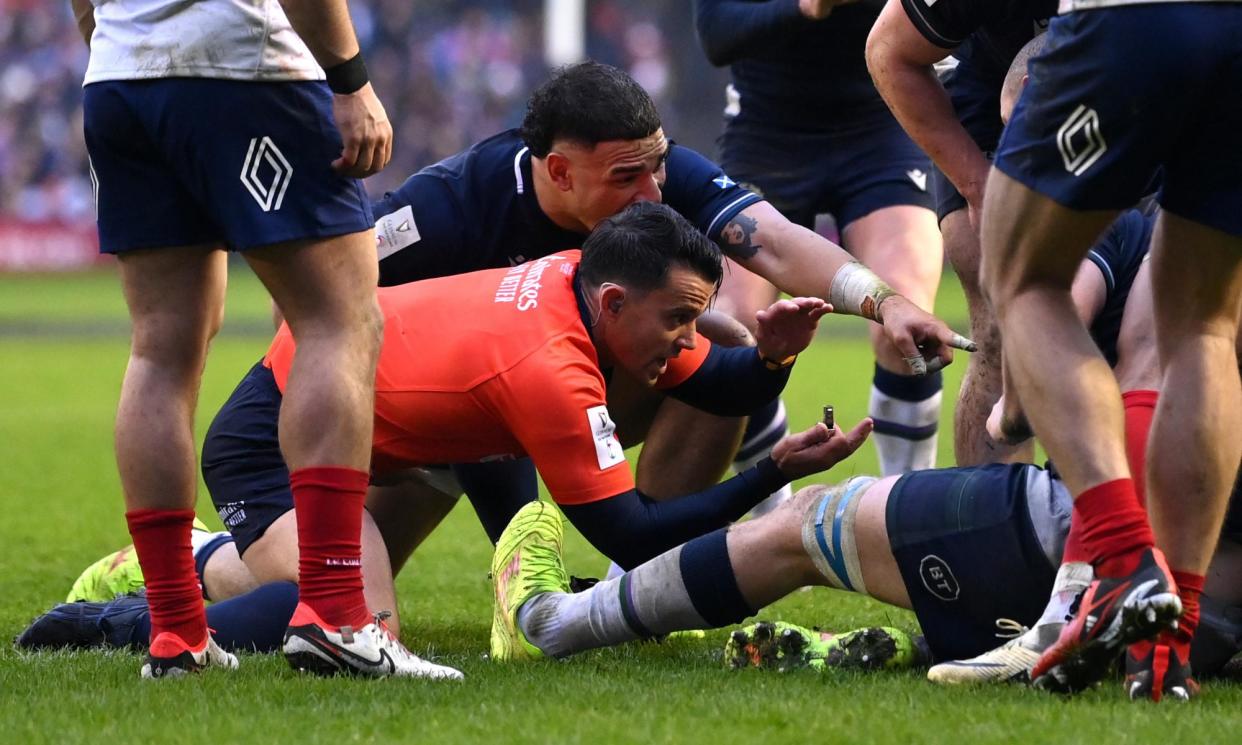
It was like waiting for the result of a referendum: were Scotland the real deal, one of the big dogs of world rugby, a team that could deliver while carrying the weight of expectation? Or were they pretenders, a flashy but flawed side that didn’t have the sand to sit at the sport’s top table? The decision would fall to the television match official Brian MacNeice after the referee Nic Berry deemed Sam Skinner’s pick-and-go was held up over the line. With France leading 20‑16 at Murrayfield after the 80th minute, this would be the last act of the match.
Multiple replays. Frames crawling across the screen. The ball probably touched the turf after sliding off a French foot. But probably wasn’t enough to overturn the decision. Protocol must be followed and Berry’s original call carried more weight than the evidence of our eyes. No try.
Related: Robbie Henshaw busy adding layers to Ireland’s precision machine
“If I was the TMO, based on the evidence that I saw, I would have awarded the try,” says Nigel Owens, a retired referee who, for 19 years, was one of the most respected officials in the game.
“The benefit of the doubt should always go to the attacking team. That’s how it used to be. My philosophy is similar to the awarding of penalty tries. You can never say if a try would definitely have been scored. You go on probability and I’d say the ball was probably grounded.”
Rugby is often accused of being mired in tradition but it is also in a constant state of evolution. In addition to almost annual law changes and ever-improving safety procedures, the use of technology has helped enhance the spectacle as well as assist officials reach more accurate conclusions. But, according to Owens, there has been a negative side effect.
“Technology has made people expect that decisions are black and white, but refereeing is about interpreting the massive grey areas in rugby,” Owens says. “Technology has created this environment where we have controversies every week. It’s used too much and I’d say it’s made refereeing worse. It’s like walking a tightrope between two high buildings. If you took away the safety net you’d be damned sure that anyone who steps on that rope would know what they’re doing. With a safety net there’s a licence to get things wrong.
“Technology was also supposed to lessen the abuse directed at referees but it’s only highlighted their mistakes. It puts them under a spotlight and anyone with social media can pile on. There’s never been more hate for referees.”
A report published this month by World Rugby found that match officials received 49% of the total volume of directed abuse during the World Cup last year. Wayne Barnes, who took charge of the final where he sent off the New Zealand captain, Sam Cane, and disallowed an All Blacks try against South Africa, was the single most targeted individual with three other referees among the top nine.
As a result, Owens would like to see technology stripped back to determine only whether or not a ball has been grounded over the line, which brings us back full circle. Right now officials must make do with grainy replays but could soon have an extra tool at their disposal.
Every Gilbert ball at the Six Nations is equipped with a microchip that is tracked by 10 beacons placed around the stadium. Sportable, the company that has developed the technology, works with broadcasters and teams to aid in their analysis while communicating with referees. A so-called smart ball was trialled at the World Rugby Under-20 Championship last year and captured in real time the ball’s trajectory, revolution and precise position on the pitch. This helped eliminate the guesswork concerning lineout locations and forward pass decisions. The one missing piece, all stakeholders report, concerns the grounding of the ball.
“We have ideas and concepts that are in the early stages [of research and development],” says James Lewis, Sportable’s head of broadcast.
“It is on our road map but is a long-term project. It’s important to note that there’s a number of factors at play, for instance, a grounding may require pressure or pressing down on the ball. But if a player is holding the ball, downward pressure isn’t necessarily required for a try to be awarded.” As such, Lewis says that, for now, video replays will have to do.
That doesn’t mean the game is at a stalemate. Owens argues that a recalibration of the laws would resolve the issue. “We need to reward attacking rugby,” he says. “I’d change the ‘held-up’ law. I think it rewards negative play where you can effectively just fall under the ball to win it back. That law was made to encourage teams to pass down the line rather than pick-and-go, but it hasn’t worked like that. What I’d do in that situation is award a five-metre scrum to the attacking team.”
Perhaps that would have given Scotland the chance to rewrite the result of a referendum while diluting the vitriol spewed at officials who were simply following protocol.
Article courtesy of
Source link